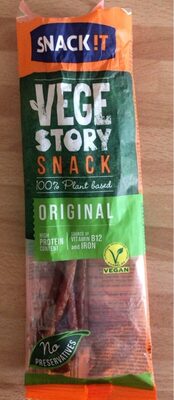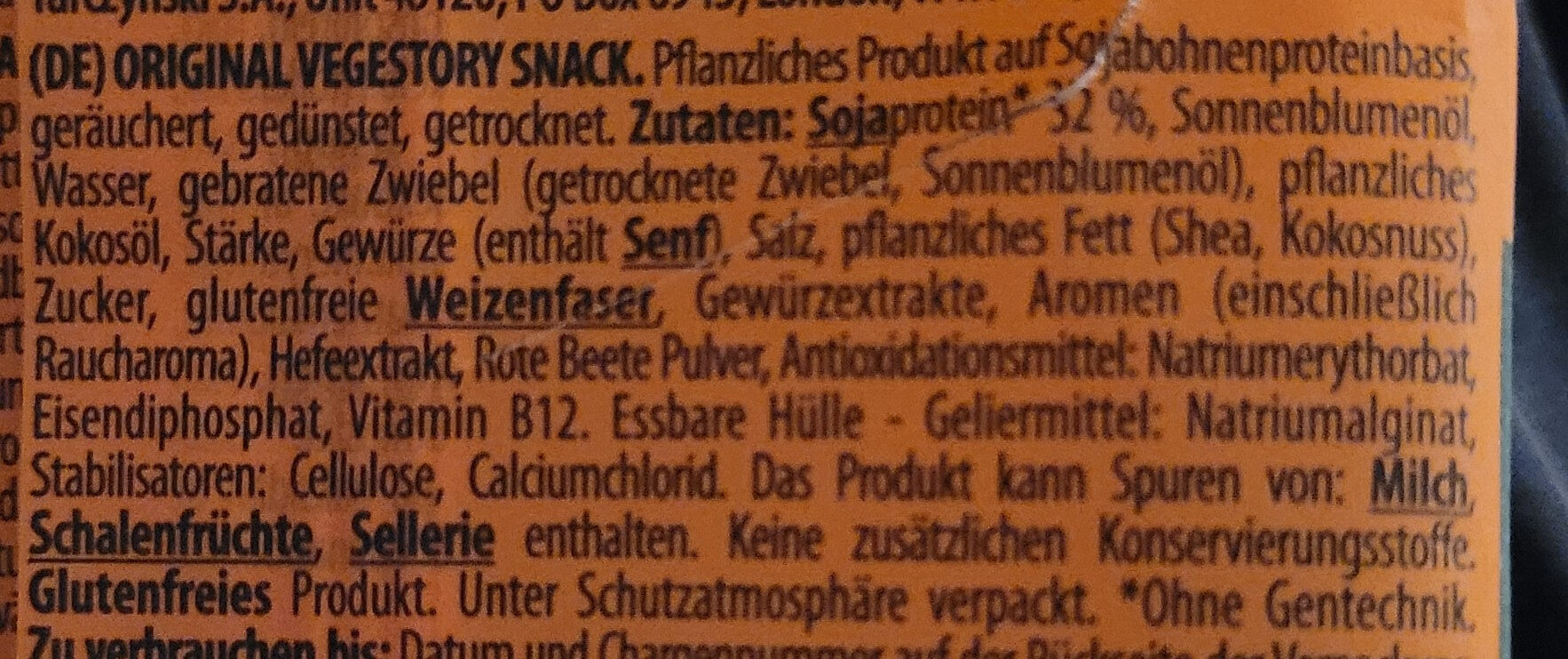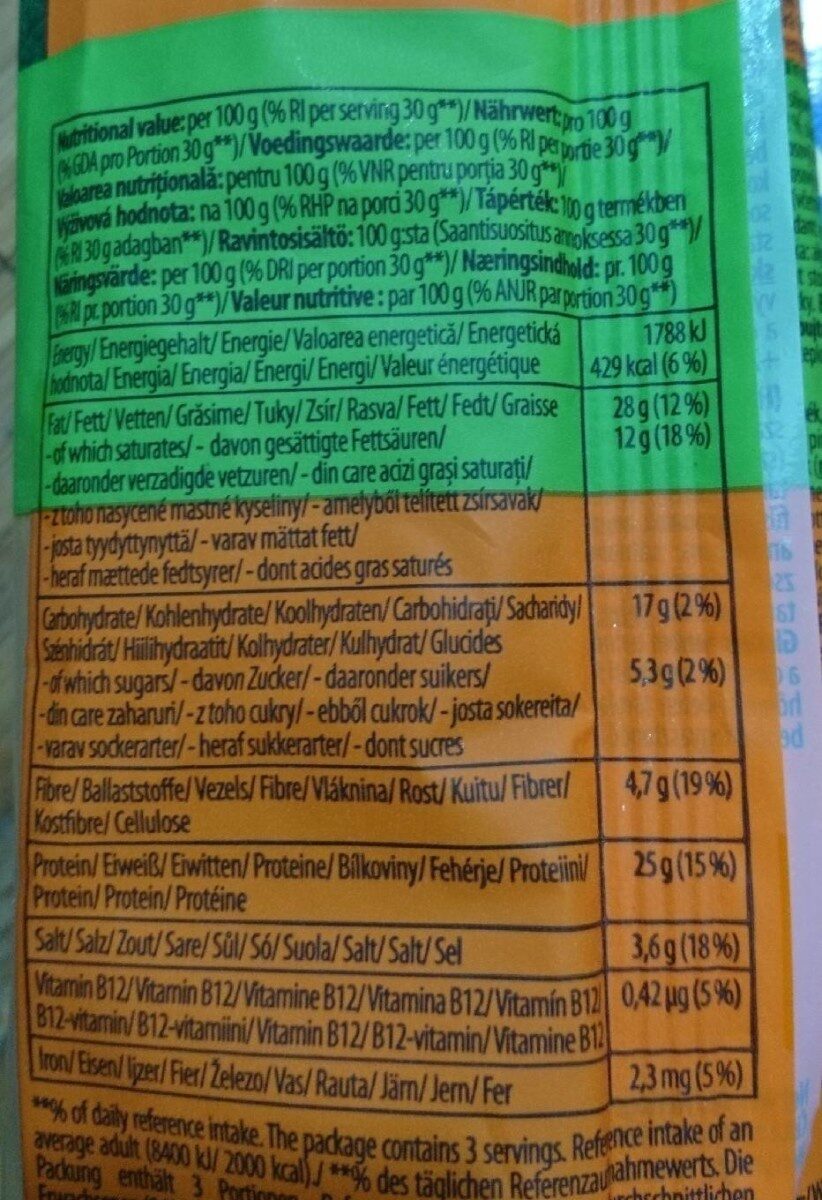Help us make food transparency the norm!
As a non-profit organization, we depend on your donations to continue informing consumers around the world about what they eat.
The food revolution starts with you!
Vege Story Snack Original - SNACK!T - 90g
Vege Story Snack Original - SNACK!T - 90g
This product page is not complete. You can help to complete it by editing it and adding more data from the photos we have, or by taking more photos using the app for Android or iPhone/iPad. Thank you!
×
Barcode: 5908230530265 (EAN / EAN-13)
Quantity: 90g
Packaging: Plastic
Brands: SNACK!T, Tarczyński
Categories: Plant-based foods and beverages, Plant-based foods, Snacks, Meat alternatives, Meat analogues, Vegetarian sausages, Vegan sausages
Labels, certifications, awards:
No gluten, Vegetarian, No GMOs, No preservatives, Source of proteins, Vegan, European Vegetarian Union, European Vegetarian Union Vegan, High proteins, Iron source, Vitamin B12 source

Manufacturing or processing places: Poland
Stores: Globus
Countries where sold: Czech Republic, Germany
Matching with your preferences
Health
Ingredients
-
29 ingredients
German: Sojaprotein 32 %, Sonnenblumenöl, Wasser, gebratene Zwiebel (getrocknete Zwiebel, Sonnenblumenöl), Kokosöl, Stärke, Gewürze (enthält Senf), Salz, pflanzliches Fett (Shea, Kokosnuss), Zucker, glutenfreie Weizenfaser, Gewürzextrakte, Aromen (Raucharoma), Hefeextrakt, Rote Beete Pulver, Antioxidationsmittel: Natriumerythorbat, Eisendiphosphat, Vitamin B12; Geliermittel: Natriumalginat; Stabilisatoren: Cellulose, CalciumchloridAllergens: SoybeansTraces: Celery, Milk, Nuts
Food processing
-
Ultra processed foods
Elements that indicate the product is in the 4 - Ultra processed food and drink products group:
- Additive: E401 - Sodium alginate
- Additive: E460 - Cellulose
- Ingredient: Flavouring
- Ingredient: Gelling agent
Food products are classified into 4 groups according to their degree of processing:
- Unprocessed or minimally processed foods
- Processed culinary ingredients
- Processed foods
- Ultra processed foods
The determination of the group is based on the category of the product and on the ingredients it contains.
Additives
-
E316 - Sodium erythorbate
Sodium erythorbate: Sodium erythorbate -C6H7NaO6- is a food additive used predominantly in meats, poultry, and soft drinks. Chemically, it is the sodium salt of erythorbic acid. When used in processed meat such as hot dogs and beef sticks, it increases the rate at which nitrite reduces to nitric oxide, thus facilitating a faster cure and retaining the pink coloring. As an antioxidant structurally related to vitamin C, it helps improve flavor stability and prevents the formation of carcinogenic nitrosamines. When used as a food additive, its E number is E316. The use of erythorbic acid and sodium erythorbate as a food preservative has increased greatly since the U.S. Food and Drug Administration banned the use of sulfites as preservatives in foods intended to be eaten fresh -such as ingredients for fresh salads- and as food processors have responded to the fact that some people are allergic to sulfites. It can also be found in bologna, and is occasionally used in beverages, baked goods, and potato salad.Sodium erythorbate is produced from sugars derived from different sources, such as beets, sugar cane, and corn. An urban myth claims that sodium erythorbate is made from ground earthworms; however, there is no truth to the myth. It is thought that the genesis of the legend comes from the similarity of the chemical name to the words earthworm and bait.Alternative applications include the development of additives that could be utilized as anti-oxidants in general. For instance, this substance has been implemented in the development of corrosion inhibitors for metals and it has been implemented in active packaging.Sodium erythorbate is soluble in water. The pH of the aqueous solution of the sodium salt is between 5 and 6. A 10% solution, made from commercial grade sodium erythorbate, may have a pH of 7.2 to 7.9. In its dry, crystalline state it is nonreactive. But, when in solution with water it readily reacts with atmospheric oxygen and other oxidizing agents, which makes it a valuable antioxidant.Source: Wikipedia
-
E460 - Cellulose
Cellulose: Cellulose is an organic compound with the formula -C6H10O5-n, a polysaccharide consisting of a linear chain of several hundred to many thousands of β-1→4- linked D-glucose units. Cellulose is an important structural component of the primary cell wall of green plants, many forms of algae and the oomycetes. Some species of bacteria secrete it to form biofilms. Cellulose is the most abundant organic polymer on Earth. The cellulose content of cotton fiber is 90%, that of wood is 40–50%, and that of dried hemp is approximately 57%.Cellulose is mainly used to produce paperboard and paper. Smaller quantities are converted into a wide variety of derivative products such as cellophane and rayon. Conversion of cellulose from energy crops into biofuels such as cellulosic ethanol is under development as a renewable fuel source. Cellulose for industrial use is mainly obtained from wood pulp and cotton.Some animals, particularly ruminants and termites, can digest cellulose with the help of symbiotic micro-organisms that live in their guts, such as Trichonympha. In human nutrition, cellulose is a non-digestible constituent of insoluble dietary fiber, acting as a hydrophilic bulking agent for feces and potentially aiding in defecation.Source: Wikipedia
Ingredients analysis
-
Palm oil free
No ingredients containing palm oil detected
Unrecognized ingredients: de:glutenfreie-weizenfaserSome ingredients could not be recognized.
We need your help!
You can help us recognize more ingredients and better analyze the list of ingredients for this product and others:
- Edit this product page to correct spelling mistakes in the ingredients list, and/or to remove ingredients in other languages and sentences that are not related to the ingredients.
- Add new entries, synonyms or translations to our multilingual lists of ingredients, ingredient processing methods, and labels.
If you would like to help, join the #ingredients channel on our Slack discussion space and/or learn about ingredients analysis on our wiki. Thank you!
-
Vegan
No non-vegan ingredients
Unrecognized ingredients: Mustard, de:glutenfreie-weizenfaser, Ferric diphosphate, Vitamin b12Some ingredients could not be recognized.
We need your help!
You can help us recognize more ingredients and better analyze the list of ingredients for this product and others:
- Edit this product page to correct spelling mistakes in the ingredients list, and/or to remove ingredients in other languages and sentences that are not related to the ingredients.
- Add new entries, synonyms or translations to our multilingual lists of ingredients, ingredient processing methods, and labels.
If you would like to help, join the #ingredients channel on our Slack discussion space and/or learn about ingredients analysis on our wiki. Thank you!
-
Vegetarian
No non-vegetarian ingredients detected
Unrecognized ingredients: Mustard, de:glutenfreie-weizenfaser, Ferric diphosphate, Vitamin b12Some ingredients could not be recognized.
We need your help!
You can help us recognize more ingredients and better analyze the list of ingredients for this product and others:
- Edit this product page to correct spelling mistakes in the ingredients list, and/or to remove ingredients in other languages and sentences that are not related to the ingredients.
- Add new entries, synonyms or translations to our multilingual lists of ingredients, ingredient processing methods, and labels.
If you would like to help, join the #ingredients channel on our Slack discussion space and/or learn about ingredients analysis on our wiki. Thank you!
-
Details of the analysis of the ingredients
We need your help!
Some ingredients could not be recognized.
We need your help!
You can help us recognize more ingredients and better analyze the list of ingredients for this product and others:
- Edit this product page to correct spelling mistakes in the ingredients list, and/or to remove ingredients in other languages and sentences that are not related to the ingredients.
- Add new entries, synonyms or translations to our multilingual lists of ingredients, ingredient processing methods, and labels.
If you would like to help, join the #ingredients channel on our Slack discussion space and/or learn about ingredients analysis on our wiki. Thank you!
de: Sojaprotein 32%, Sonnenblumenöl, Wasser, Zwiebel (Zwiebel, Sonnenblumenöl), Kokosöl, Stärke, Gewürze (enthält Senf), Salz, Sheafett, Kokosnussfett, Zucker, glutenfreie Weizenfaser, Gewürzextrakte, Aromen (Raucharoma), Hefeextrakt, Rote Beete, Antioxidationsmittel (Natriumerythorbat), Eisendiphosphat, Vitamin B12, Geliermittel (Natriumalginat), Stabilisatoren (Cellulose), Calciumchlorid- Sojaprotein -> en:soy-protein - vegan: yes - vegetarian: yes - ciqual_food_code: 20591 - percent_min: 32 - percent: 32 - percent_max: 32
- Sonnenblumenöl -> en:sunflower-oil - vegan: yes - vegetarian: yes - from_palm_oil: no - ciqual_food_code: 17440 - percent_min: 3.23809523809524 - percent_max: 32
- Wasser -> en:water - vegan: yes - vegetarian: yes - ciqual_food_code: 18066 - percent_min: 1.8 - percent_max: 32
- Zwiebel -> en:onion - vegan: yes - vegetarian: yes - ciqual_food_code: 20034 - percent_min: 0.210526315789474 - percent_max: 25
- Zwiebel -> en:onion - vegan: yes - vegetarian: yes - ciqual_food_code: 20034 - percent_min: 0.105263157894737 - percent_max: 25
- Sonnenblumenöl -> en:sunflower-oil - vegan: yes - vegetarian: yes - from_palm_oil: no - ciqual_food_code: 17440 - percent_min: 0 - percent_max: 12.5
- Kokosöl -> en:coconut-oil - vegan: yes - vegetarian: yes - from_palm_oil: no - ciqual_food_code: 16040 - percent_min: 0 - percent_max: 20
- Stärke -> en:starch - vegan: yes - vegetarian: yes - ciqual_proxy_food_code: 9510 - percent_min: 0 - percent_max: 16.1378446115288
- Gewürze -> en:spice - vegan: yes - vegetarian: yes - percent_min: 0 - percent_max: 12.9102756892231
- enthält Senf -> en:mustard - ciqual_food_code: 11013 - percent_min: 0 - percent_max: 12.9102756892231
- Salz -> en:salt - vegan: yes - vegetarian: yes - ciqual_food_code: 11058 - percent_min: 0 - percent_max: 3.6
- Sheafett -> en:shea-butter - vegan: yes - vegetarian: yes - from_palm_oil: no - percent_min: 0 - percent_max: 3.6
- Kokosnussfett -> en:coconut-fat - vegan: yes - vegetarian: yes - from_palm_oil: no - ciqual_food_code: 16040 - percent_min: 0 - percent_max: 3.6
- Zucker -> en:sugar - vegan: yes - vegetarian: yes - ciqual_proxy_food_code: 31016 - percent_min: 0 - percent_max: 3.6
- glutenfreie Weizenfaser -> de:glutenfreie-weizenfaser - percent_min: 0 - percent_max: 3.6
- Gewürzextrakte -> en:spice-extract - vegan: yes - vegetarian: yes - percent_min: 0 - percent_max: 3.6
- Aromen -> en:flavouring - vegan: maybe - vegetarian: maybe - percent_min: 0 - percent_max: 3.6
- Raucharoma -> en:smoke-flavouring - vegan: maybe - vegetarian: maybe - percent_min: 0 - percent_max: 3.6
- Hefeextrakt -> en:yeast-extract - vegan: yes - vegetarian: yes - percent_min: 0 - percent_max: 3.6
- Rote Beete -> en:red-beetroot - vegan: yes - vegetarian: yes - ciqual_food_code: 20091 - percent_min: 0 - percent_max: 3.6
- Antioxidationsmittel -> en:antioxidant - percent_min: 0 - percent_max: 3.6
- Natriumerythorbat -> en:e316 - vegan: yes - vegetarian: yes - percent_min: 0 - percent_max: 3.6
- Eisendiphosphat -> en:ferric-diphosphate - percent_min: 0 - percent_max: 3.6
- Vitamin B12 -> en:vitamin-b12 - percent_min: 0 - percent_max: 3.6
- Geliermittel -> en:gelling-agent - percent_min: 0 - percent_max: 3.6
- Natriumalginat -> en:e401 - vegan: yes - vegetarian: yes - percent_min: 0 - percent_max: 3.6
- Stabilisatoren -> en:stabiliser - percent_min: 0 - percent_max: 3.39744097084817
- Cellulose -> en:e460 - vegan: yes - vegetarian: yes - percent_min: 0 - percent_max: 3.39744097084817
- Calciumchlorid -> en:e509 - vegan: yes - vegetarian: yes - percent_min: 0 - percent_max: 3.22756892230576
Nutrition
-
Bad nutritional quality
⚠ ️Warning: the amount of fruits, vegetables and nuts is not specified on the label, it was estimated from the list of ingredients: 12This product is not considered a beverage for the calculation of the Nutri-Score.
Positive points: 4
- Proteins: 5 / 5 (value: 25, rounded value: 25)
- Fiber: 4 / 5 (value: 4.7, rounded value: 4.7)
- Fruits, vegetables, nuts, and colza/walnut/olive oils: 0 / 5 (value: 12.6052631578947, rounded value: 12.6)
Negative points: 26
- Energy: 5 / 10 (value: 1788, rounded value: 1788)
- Sugars: 1 / 10 (value: 5.3, rounded value: 5.3)
- Saturated fat: 10 / 10 (value: 12, rounded value: 12)
- Sodium: 10 / 10 (value: 1440, rounded value: 1440)
The points for proteins are not counted because the negative points are greater or equal to 11.
Nutritional score: (26 - 4)
Nutri-Score:
-
Nutrient levels
-
Fat in high quantity (28%)
What you need to know- A high consumption of fat, especially saturated fats, can raise cholesterol, which increases the risk of heart diseases.
Recommendation: Limit the consumption of fat and saturated fat- Choose products with lower fat and saturated fat content.
-
Saturated fat in high quantity (12%)
What you need to know- A high consumption of fat, especially saturated fats, can raise cholesterol, which increases the risk of heart diseases.
Recommendation: Limit the consumption of fat and saturated fat- Choose products with lower fat and saturated fat content.
-
Sugars in moderate quantity (5.3%)
What you need to know- A high consumption of sugar can cause weight gain and tooth decay. It also augments the risk of type 2 diabetes and cardio-vascular diseases.
Recommendation: Limit the consumption of sugar and sugary drinks- Sugary drinks (such as sodas, fruit beverages, and fruit juices and nectars) should be limited as much as possible (no more than 1 glass a day).
- Choose products with lower sugar content and reduce the consumption of products with added sugars.
-
Salt in high quantity (3.6%)
What you need to know- A high consumption of salt (or sodium) can cause raised blood pressure, which can increase the risk of heart disease and stroke.
- Many people who have high blood pressure do not know it, as there are often no symptoms.
- Most people consume too much salt (on average 9 to 12 grams per day), around twice the recommended maximum level of intake.
Recommendation: Limit the consumption of salt and salted food- Reduce the quantity of salt used when cooking, and don't salt again at the table.
- Limit the consumption of salty snacks and choose products with lower salt content.
-
-
Nutrition facts
Nutrition facts As sold
for 100 g / 100 mlAs sold
per serving (30g)Compared to: Vegan sausages Energy 1,788 kj
(429 kcal)536 kj
(129 kcal)+84% Fat 28 g 8.4 g +103% Saturated fat 12 g 3.6 g +330% Carbohydrates 17 g 5.1 g +86% Sugars 5.3 g 1.59 g +172% Fiber 4.7 g 1.41 g -2% Proteins 25 g 7.5 g +69% Salt 3.6 g 1.08 g +95% Vitamin B12 (cobalamin) 0.42 µg 0.126 µg -11% Iron 2.3 mg 0.69 mg -50% Fruits‚ vegetables‚ nuts and rapeseed‚ walnut and olive oils (estimate from ingredients list analysis) 12.605 % 12.605 %
Environment
-
Eco-Score B - Low environmental impact
⚠ ️Select a country in order to include the full impact of transportation.The Eco-Score is an experimental score that summarizes the environmental impacts of food products.→ The Eco-Score was initially developped for France and it is being extended to other European countries. The Eco-Score formula is subject to change as it is regularly improved to make it more precise and better suited to each country.Life cycle analysis
-
Average impact of products of the same category: A (Score: 90/100)
Category: Plant-based sausage with tofu (vegan)
Category: Plant-based sausage with tofu (vegan)
- PEF environmental score: 0.19 (the lower the score, the lower the impact)
- including impact on climate change: 1.33 kg CO2 eq/kg of product
Stage Impact Agriculture
30.6 %Processing
38.1 %Packaging
10.1 %Transportation
9.2 %Distribution
5.7 %Consumption
6.2 %
Bonuses and maluses
-
Missing origins of ingredients information
Malus: -5
⚠ ️ The origins of the ingredients of this product are not indicated.
If they are indicated on the packaging, you can modify the product sheet and add them.
If you are the manufacturer of this product, you can send us the information with our free platform for producers.
-
Packaging with a medium impact
Malus: -10
Shape Material Recycling Impact Unknown Plastic High ⚠ ️ The information about the packaging of this product is not sufficiently precise (exact shapes and materials of all components of the packaging).⚠ ️ For a more precise calculation of the Eco-Score, you can modify the product page and add them.
If you are the manufacturer of this product, you can send us the information with our free platform for producers.
Eco-Score for this product
-
Impact for this product: B (Score: 75/100)
Product: Vege Story Snack Original - SNACK!T - 90g
Life cycle analysis score: 90
Sum of bonuses and maluses: -15
Final score: 75/100
-
Carbon footprint
-
Equal to driving 0.7 km in a petrol car
133 g CO² per 100g of product
The carbon emission figure comes from ADEME's Agribalyse database, for the category: Plant-based sausage with tofu (vegan) (Source: ADEME Agribalyse Database)
Stage Impact Agriculture
27.5 %Processing
28.4 %Packaging
17.6 %Transportation
16.8 %Distribution
3.0 %Consumption
6.7 %
Packaging
-
Packaging with a medium impact
-
Packaging parts
(Plastic)
-
Packaging materials
Material % Packaging weight Packaging weight per 100 g of product Plastic
-
Transportation
-
Origins of ingredients
Missing origins of ingredients information
⚠ ️ The origins of the ingredients of this product are not indicated.
If they are indicated on the packaging, you can modify the product sheet and add them.
If you are the manufacturer of this product, you can send us the information with our free platform for producers.Add the origins of ingredients for this product Add the origins of ingredients for this product
Report a problem
-
Incomplete or incorrect information?
Category, labels, ingredients, allergens, nutritional information, photos etc.
If the information does not match the information on the packaging, please complete or correct it. Open Food Facts is a collaborative database, and every contribution is useful for all.
Data sources
Product added on by atillasezen
Last edit of product page on by femmenoire.
Product page also edited by arc2, kiliweb, manuelr, mazechazer, openfoodfacts-contributors, packbot, prepperapp, risajanda, yuka.sY2b0xO6T85zoF3NwEKvlhN-TILFniD-GTXghVKO28WCEsXLMPR7uJKlEao, yuka.sY2b0xO6T85zoF3NwEKvll5lbvGOom7DPj7fsk-GycalKZDhc8FJwbTIbqs, yuka.sY2b0xO6T85zoF3NwEKvllAXfduCgTXcLybuplTS__2IL7yyaotzwJSjaas.










